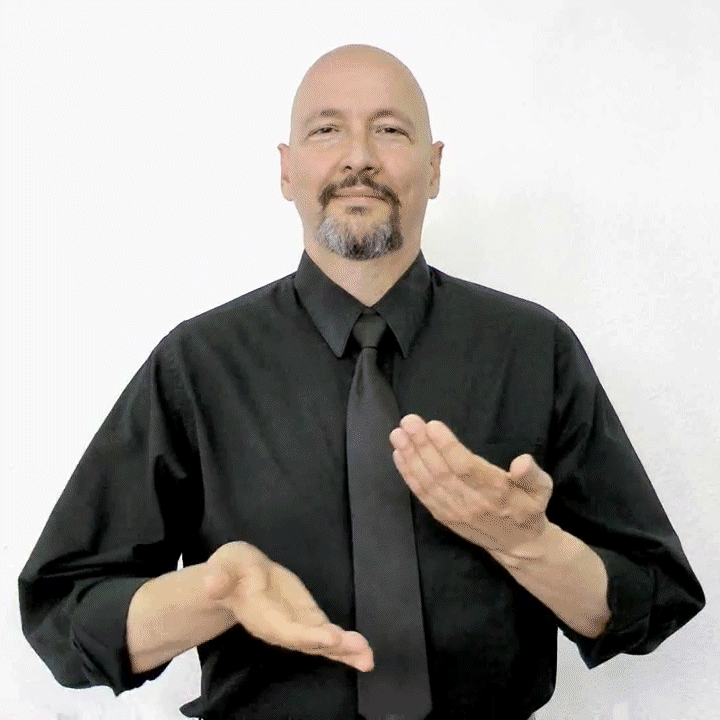easy: The
American Sign Language (ASL) sign for "easy"
Compare with: ALMOST
When doing the sign for easy (if you are right handed) the right hand brushes up twice against the left hand fingers. The left hand doesn't move. Let me say that again, the left hand is stationary. The only movement in the left hand is a slight bending of the fingers as the right hand brushes upward against it. See: Easy: https://youtu.be/HD10hA6FKFs
EASY:


Sample sentence: Do you think this class is easy?







Notes:
If you do this sign with a single motion this sign will mean "almost."
See: ALMOST
Also see: SIMPLE
Topic: "EASIER"
QUESTION:
Dr. Bill -
I am just learning ASL at age 62. I feel like I'm doing well, considering social
isolation and my age! This question has come up and there is no one to ask...
The current situation is bad - it may never get easy, but we hope it will get
easier. In that sentence, the difference between "easy" and "easier" is
important but I can't seem to find "easier" on your site or any other. I've seen
moving a thumb to point over your right shoulder to make a word sort of more,
but I don't know if that works here.
- Debra
ANSWER:
Hello Debra!
You are seeking the ASL equivalent of the word "easier" which is a comparative
adjective form of the word "easy."
The easiest (heh) way of signing "easier" is to simply add the ASL suffix "-ER"
to the sign EASY. (The ASL suffix "-ER" consists of an open-A hand / "thumb up"
that moves upward a short distance.)
Another way to express the concept of "easier" is to use a contrastive structure
(in your sentence) by comparing something that is easy with something that is
easier. To do this you lean or point to your non-dominant side and mention
that something is "easy" (using the normal sign for "easy") -- then you lean or
point to your dominant side and indicate that something else is "easier" (using
an exaggerated sign for "easy" with a large movement, more facial expression,
and an affirming head nod). Thus the concept of "-er" (as in "more so") is being
expressed not by an added sign but rather by inflecting (modifying) the way you
sign "easy" and doing so using "contrastive" sentence structure (comparing
something on one side with something else on the other side).
Here is some homework for you. Check out the following video:
Superlatives and Comparatives in ASL:
https://youtu.be/7T_pxoNWs3o
Another approach is to sign:
"MORE EASY."
Or "MORE EASY THAN."
Consider your sentence as a whole. If you are discussing a "hard situation
that will get easier" you might want to just sign "SITUATION IMPROVE WILL"
For example, your sentence:
"The current situation is bad - it may never get easy, but we hope it will get
easier."
Could be signed as:
NOW SITUATION BAD. FUTURE BECOME EASY? MAYBE NEVER? BUT, FUTURE SITUATION
IMPROVE WE HOPE.
Or another version could be:
NOW SITUATION BAD. FUTURE BECOME EASY? MAYBE NEVER? BUT, WE HOPE FUTURE
SITUATION MORE EASY.
While I do not recommend it for all situations of "-er" -- sometimes an option
to express "this is easier than that" is to sign the "beats" sign then sign
EASY.
This can create a meaning of: "This beats that in terms of easiness" --
but you have to be careful to use such signing only in high context situations
because signing "BEAT-[right-to-left] EASY" also can create the meaning of "this
easily beats that."
See: "override-[this-BEAT-that] / prevail"
https://youtu.be/femhWu3HFRI
Also, you said that you saw an example of "moving a thumb to point over your
right shoulder to make a word sort of more."
I'd advise you regarding comparatives and superlatives (such as the suffixes "-er"
and "-est") that the movement is "not" over the shoulder but rather the movement
is up.
To be specific the the movement of the "open-A" hand (of signs involving
"-er" and/or "-est") is "up" (not over your dominant shoulder).
Why? If you do an open-A hand over or toward your dominant shoulder you
run the risk of looking like your are signing "WON'T (as in "refuse to do
something").
See: WON'T: https://youtu.be/u2W72GqhsaM
*
Want to help support ASL University? It's easy:
DONATE (Thanks!)
* Another way to help is to buy something from Dr. Bill's "Bookstore."
* Want even more ASL resources? Visit the "ASL Training Center!" (Subscription
Extension of ASLU)
* Also check out Dr. Bill's channel:
www.youtube.com/billvicars
You can learn American Sign Language (ASL) online at American Sign Language University ™
ASL resources by Lifeprint.com © Dr. William Vicars